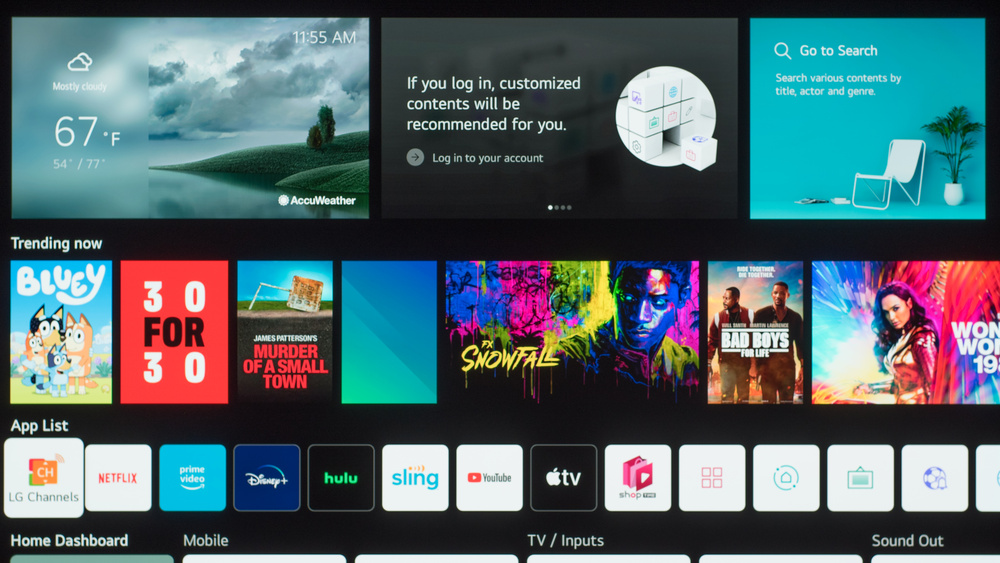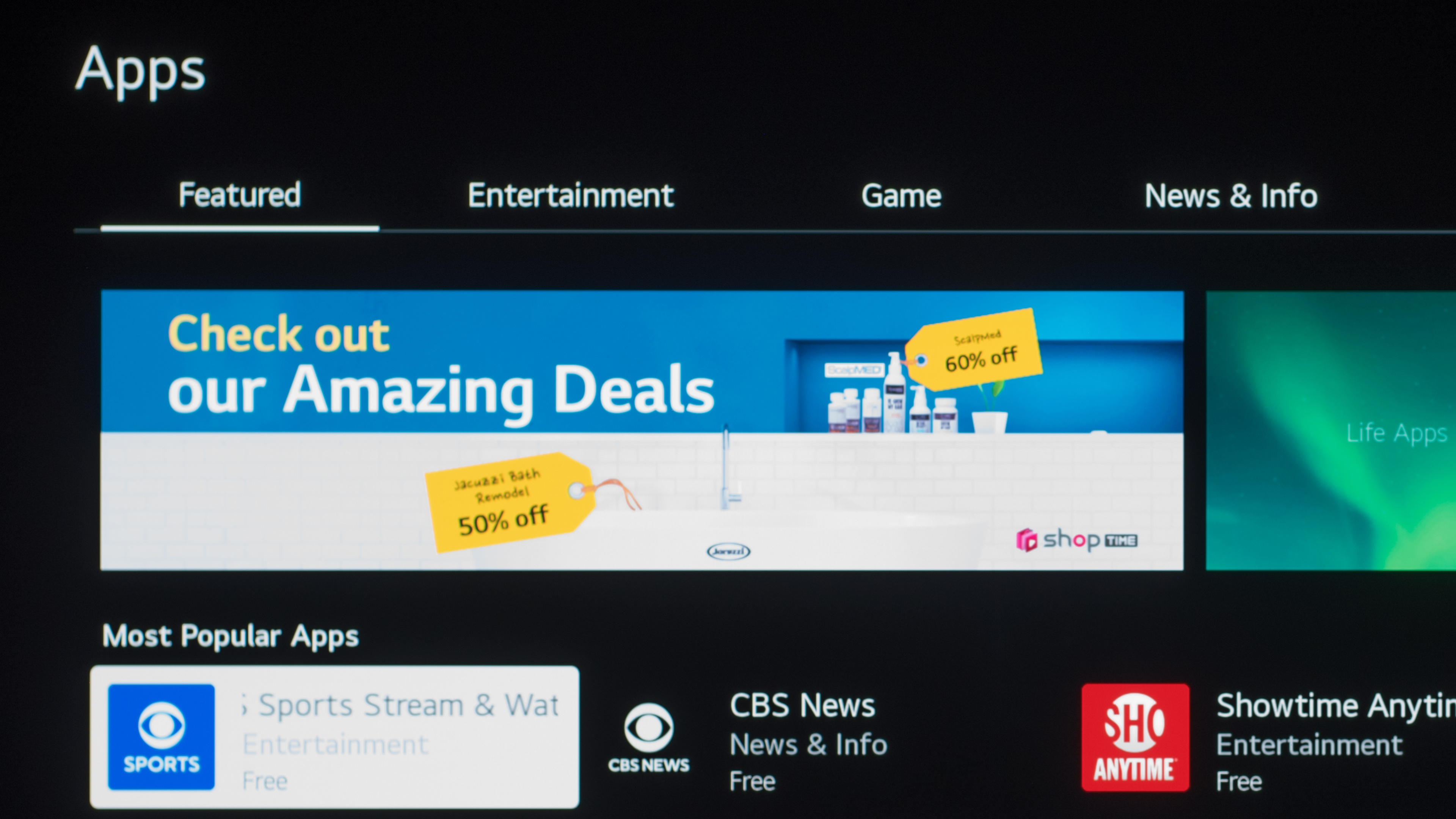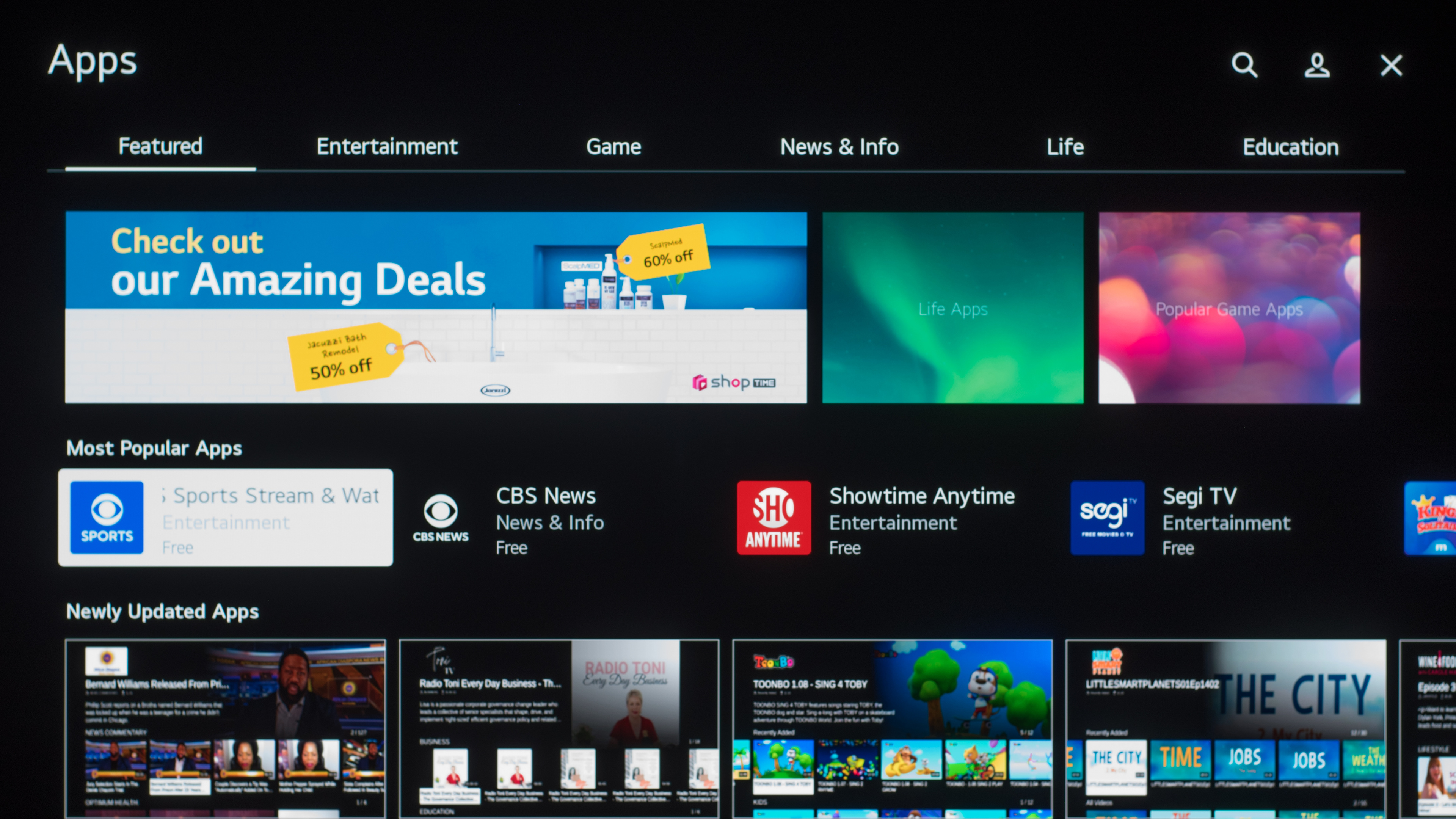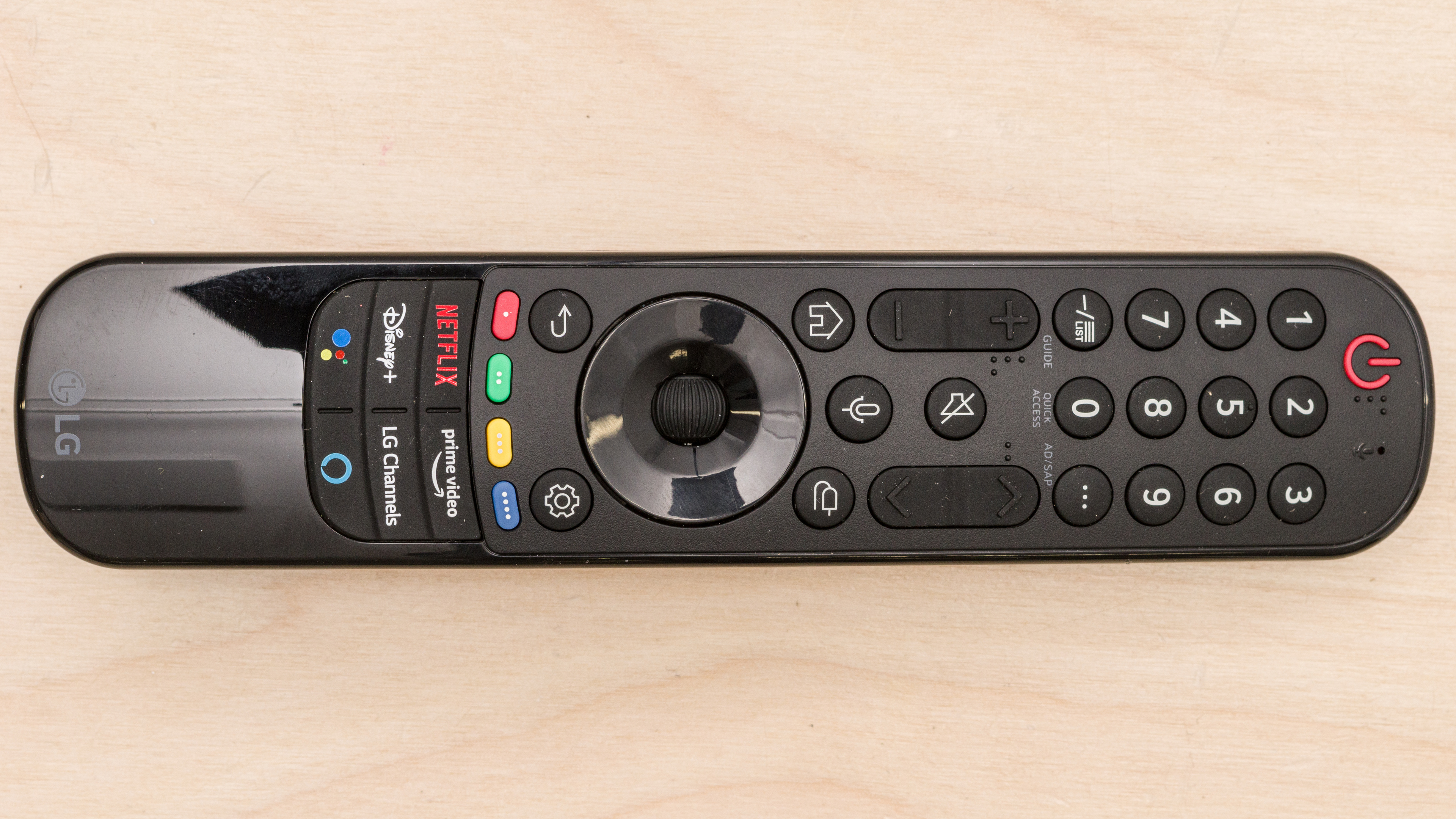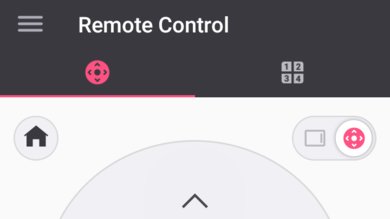
We buy and test dozens of TVs each year, and we've bought and tested more than 110 LG TVs. LG releases many TVs every year, as much as any other manufacturer. LG was one of the first brands to release TVs with OLED panels, and that's now their most popular lineup. They also have a wide selection of LED TVs, ranging from entry-level 4k TVs to high-end models with Mini LED backlights. Unfortunately, most of their LED TVs don't perform very well overall, so our LG TV reviews aren't very positive when it comes to their LED models. But if you're looking for a brand with a large variety of excellent OLED TVs, LG is it.
You can vote on which LG TVs you want us to buy and test, or check out our 2025 TV lineup page.
Updates
- 04/11/2025 LG QNED90T updated
- 03/18/2025 LG C4 OLED updated
- 03/12/2025 LG B4 OLED updated
- 03/07/2025 LG UT7570 [UT75, UT7590] updated
- 03/07/2025 LG G4 OLED updated
-
Best LG TV
Mixed Usage8.6Home Theater8.7Bright Room7.7Sports8.1Gaming8.9Performance Usages: Brightness8.3Black Level10Color8.2Processing (In Development)8.4Game Mode Responsiveness9.2Motion Handling (Broken)7.6Resolution 4kNative Refresh Rate144HzScreen FinishGlossyType OLEDSub-TypeWOLEDDolby VisionYesSizes 55" 65" 77" 83" 97"The LG G4 OLED is the best LG TV and the best LG OLED TV we've tested. It uses a technology called Micro Lens Array, or MLA, making it one of the brightest OLEDs on the market; this is one of the few OLEDs that looks great in very bright rooms. It's a fantastic home theater TV due to its very good image processing, Dolby Vision HDR support, and advanced DTS audio format passthrough. Ultimately, the G4 can do it all at very high levels of brightness, and it also displays perfect blacks, so it looks incredible in dark rooms.
Like most LG TVs, the G4 has a great selection of additional gaming features, including support for 4k @ 144Hz gaming on all four of its HDMI ports, so it's a perfect choice for PS5 or Xbox Series X|S gamers. It also supports all three major variable refresh rate (VRR) technologies, ensuring a nearly tear-free gaming experience from almost any source. Like all OLED displays, it has a near-instantaneous response time, resulting in crystal-clear motion with no distracting blur behind fast-moving objects. The TV is available in five sizes: 55, 65, 77, 83, and 97 inches; however, the biggest size doesn't have MLA, so it's not as bright as the smaller models.
-
Best Upper Mid-Range LG TV
Mixed Usage8.3Home Theater8.5Bright Room6.9Sports7.4Gaming8.6Performance Usages: Brightness7.3Black Level10Color8.1Processing (In Development)8.4Game Mode Responsiveness9.3Motion Handling (Broken)7.6Resolution 4kNative Refresh Rate144HzScreen FinishGlossyType OLEDSub-TypeWOLEDDolby VisionYesSizes 42" 48" 55" 65" 77" 83"If you don't need the absolute best LG OLED TV or prefer saving money, there are a few upper mid-range and mid-range OLEDs to consider, like the LG C4 OLED. Although it's not as bright as the LG G4 OLED, it's still a great alternative and can overcome some glare in a room with the lights on. Of course, like all OLED displays, it delivers incredible picture quality, with a near-infinite contrast ratio that provides perfectly inky blacks, with no distracting blooming around bright spots in dark scenes. Overall, it has very good image processing and supports Dolby Vision HDR and advanced DTS audio formats, making it an excellent home theater TV.
Like the G4, the C4 is an incredible TV for gamers with a near-instantaneous response time that delivers crystal-clear motion. It supports HDMI 2.1 bandwidth on all four inputs for up to 4k @ 144Hz gaming with VRR, meaning you can enjoy fast gaming from the Xbox Series X|S and PS5 or a recent PC graphics card. The cherry on top is the sheer number of sizes you can buy the C4 in; from a small 42 inches to a very large 83 inches, there's something for everyone.
-
Best Mid-Range LG TV
Mixed Usage8.1Home Theater8.3Bright Room6.9Sports7.4Gaming8.5Performance Usages: Brightness6.8Black Level10Color8.1Processing (In Development)8.3Game Mode Responsiveness9.1Motion Handling (Broken)7.6Resolution 4kNative Refresh Rate120HzScreen FinishGlossyType OLEDSub-TypeWOLEDDolby VisionYesSizes 48" 55" 65" 77" 83"The LG B4 OLED is the best LG TV in the mid-range category that we've tested. It's a truly splendid option, with only a few drawbacks compared to the more expensive LG C4 OLED. The TV has all the features of the C4, like Dolby Vision and support for DTS audio formats, although the B4 is dimmer in HDR overall. However, while using the Game Optimizer, the TV's HDR brightness is essentially the same as that of its more expensive sibling, which is great. Like the C4, it delivers outstanding picture quality, with its near-infinite contrast ratio delivering inky blacks at the same time as bright highlights. It even gets bright enough in SDR to fight some glare in a room with the lights on.
Its four HDMI 2.1 bandwidth ports offer up to 4k @ 120Hz support, so you don't get the 144Hz support that the C4 and LG G4 OLED offer, but it's still fully compatible with the PS5 and Xbox Series X. It's also compatible with every VRR technology, has a nearly instantaneous response time, and has an extremely low input lag. Overall, this TV is a great entry point into the OLED market, and it's available in 48, 55, 65, 77, and 83-inch models, so it's easy to find the right size for your room.
-
Best Lower Mid-Range LG TV
Mixed Usage7.2TV Shows7.1Sports7.2Video Games7.8HDR Movies6.9HDR Gaming7.9PC Monitor7.9Resolution 4kNative Refresh Rate120 HzScreen FinishSemi-glossType LEDSub-TypeVADolby VisionNoSizes 50" 55" 65" 75" 86"If you'd rather get an affordable LED TV but don't want to lose out on features, the best lower mid-range LG TV we've tested is the LG QNED85T. It's not nearly as good as the OLEDs, but it's cheaper and doesn't skimp on many features. It doesn't support Dolby Vision like the OLEDs, but it passes through advanced DTS audio formats, which is great for physical media lovers. It's a fully featured gaming TV as well, with four HDMI 2.1 bandwidth ports capable of outputting up to 4k @ 120Hz. It also supports every VRR technology, has a very good response time, and has a superbly low input lag.
By going with this model, you're losing out on picture quality. Despite having local dimming, the TV's contrast just isn't good enough to display very deep blacks in a dark room, and there's very noticeable blooming around highlights. It's bright enough in SDR to overcome glare in a well-lit room, but its lower HDR brightness means highlights don't stand out the way they should in HDR content. Fortunately, it displays a wide range of colors, so HDR content is vibrant enough to have some impact on the viewer. Unlike the OLEDs, it has a narrow viewing angle, so it only looks its best when seated directly in front of the screen. It's available in five sizes: 50, 55, 65, 75, and a huge 86-inch model. Keep in mind that this is an edge-lit model, which is more prone to failure.
-
Best Budget LG TV
Mixed Usage4.6Home Theater4.3Bright Room5.1Sports5.7Gaming4.3Performance Usages: Brightness4.2Black Level2.1Color5.3Processing (In Development)6.9Game Mode Responsiveness5.0Motion Handling (Broken)7.3Resolution 4kNative Refresh Rate60HzScreen FinishGlossyType LEDSub-TypeIPSDolby VisionNoSizes 43" 50" 55" 65" 70" 75" 86"The best budget LG TV we've tested is the LG UT7570. It's an okay TV overall, but you don't get the same features and picture quality as the higher picks on our list. It doesn't get very bright, but it does have good enough reflection handling to fight some glare in a moderately lit room. The TV has a wide viewing angle, making it a decent option for watching content with a group of friends. Unfortunately, the TV doesn't display deep blacks due to its awful contrast, so dark scenes look gray most of the time. It also doesn't display a wide color gamut, which really holds back its HDR performance.
You won't find Dolby Vision or DTS audio support on this TV. It's also pretty barebones in terms of gaming features; it doesn't have HDMI 2.1 bandwidth or VRR. You're limited to 4k @ 60Hz, but fortunately, it has a decent response time and low input lag, so games feel responsive. It does support ALLM, so it will automatically switch to the Game Optimizer when you start up a game. The TV is available in a wide range of sizes, from a small 43-inch model to a huge 86-inch model.
Compared To Other Brands
-
OLED options.
LG's best TVs all use OLED displays, and they remain the biggest player in this market, but other brands are starting to catch up. -
Great viewing angle.
Both their LED and OLED TVs generally have wide viewing angles, making them great for wide seating areas. -
Great smart platform.
LG's proprietary smart platform, webOS, remains one of the best platforms compared to the competition. It's user-friendly, and the LG Magic Remote makes menu navigation feel smooth. -
Excellent gaming features.
Most of their mid-range models and up have a great selection of additional gaming features, including variable refresh rate support, low input lag, and HDMI 2.1 bandwidth.
-
LED TVs have a low contrast.
Aside from their high-end OLED models, most LG TVs won't have great blacks, meaning their picture quality is limited. -
Uniformity issues.
LG LED TVs often have issues with gray uniformity, like dirty screen effect (DSE), that can get distracting during sports. -
Poor value.
Besides their OLEDs, their TVs don't offer good value for what they offer in terms of performance, and better options are available.
LG vs Samsung
Samsung TVs typically have better picture quality than most LG LED TVs. This is thanks to their use of VA-type LCD panels instead of LG's IPS panels, which trade contrast directly in front for wider viewing angles. LG has started to incorporate VA panels in some of their LED offerings, but they still don't perform very well at all. While Samsung is now making QD-OLED TVs with brighter colors than LG's WOLED TVs, LG offers more OLED models at affordable prices. LG also supports Dolby Vision and DTS audio passthrough on all of their OLEDs, so they're a little more enticing for home theater enthusiasts.
LG vs Sony
Sony is a direct competitor of LG since their lineup also includes LED and OLED models. LG's OLEDs have better gaming performance and generally cost less. However, Sony's LED options usually have VA panels, making for a better dark room experience than LG's LED models, and they typically have better color accuracy and superior image processing.
LG's OLEDs are among the best on the market, with stunning picture quality, and they're often cheaper than OLEDs from other brands. However, their LED TVs aren't anything special and don't offer good value. While their IPS LCD offerings have wide viewing angles, which is helpful for larger living rooms, the competition with VA panels often outperforms them in overall picture quality.
2025 LG Lineup
LG's 2025 lineup is similar overall to their 2024 models, with a few new additions and some new technology. Most of their mid-range models have incremental improvements, so don't expect big changes to TVs like the B4 and C4. Things are a bit different with their high-end OLEDs and their QNED lineup, as LG announced at CES 2025 that they're moving away from MLA and Quantum Dot technology. Furthermore, LG also unveiled a new remote that will come with the bulk of their new models. This new remote has a lot in common with the old design, so it still utilizes motion controls. However, LG has removed the number pad and dedicated input button, but have added a new "AI" button.
OLED
The biggest LG news to come out of CES 2025 is that they've abandoned the MLA technology used in the past two years to increase brightness in their G and M Series models, but LG didn't talk about the exact panel technology replacing MLA. However, Panasonic uses OLED panels developed by LG, and they talked in more detail about this new panel technology. These OLEDs use a new 4-layer tandem RGB panel designed to increase the overall brightness of the display and greatly improve the purity of the three primary colors, giving these new models improved color volume with less washout at high luminance levels. LG calls this new technology Brightness Booster Ultimate, and they claim that it delivers up to 3x the luminance of the conventional WOLED panel used in the B5. These claims seem realistic, as we found the G4 to be around 2.1x brighter than the B4 with a 10% window. Unfortunately, the 48" and 97" models don't use this new panel, so you need to stick to the 55, 65, 77, and 83-inch sizes if you want the new technology.
LG only briefly touched on the B5 and C5 OLEDs and didn't have them on display at CES 2025, but they did confirm that the B5 will be available in limited sizes, with a 65-inch model and a yet-to-be-confirmed second size. Everything we know so far about LG's 2025 OLED lineup can be found in the table below, and we'll update this section as new information becomes available.
| Model | Sizes | Backlight Type | Resolution | Refresh Rate | Notes |
|---|---|---|---|---|---|
| M5 | 65", 77", 83", 97" | WOLED (4-stack) | 4k | 144Hz (except 97" - 120Hz) | Wireless Zero Connect, 97" uses older 3-stack OLED |
| G5 | 48", 55", 65", 77", 83", 97" | WOLED (4-stack) | 4k | 165Hz (except 48" - 144Hz, 97" - 120Hz) | 48" and 97" use older 3-stack OLED |
| C5 | 42", 48", 55", 65", 77", 83" | WOLED (3-stack) | 4k | 144Hz | |
| B5 | TBC | WOLED (3-stack) | 4k | 120Hz |
LED
LG also announced new versions of most of their QNED lineup for 2025. The biggest news for this lineup is that LG decided to move away from using quantum dots and are introducing their own technology known as Dynamic QNED Color Solution, designed to display brighter and more vibrant colors. LG also announced the new QNED9M, which is part of their new QNED Evo lineup and uses LG's wireless Zero Connect box. This external box allows for wireless streaming up to 4k @ 144Hz, which is great for people who have devices they don't place next to their TVs, like PC gamers.
Everything we know so far about LG's 2025 QNED lineup can be found in the table below. We'll update this section as more information becomes available.
| Model | Sizes | Backlight Type | Advertised Zones | Resolution | Refresh Rate | Notes |
|---|---|---|---|---|---|---|
| QNED9M | 65", 75", 86" | Mini LED | Unknown | 4k | 144hz | Wireless Zero Connect |
| QNED90A | 55", 65", 75", 85" | Mini LED | Unknown | 4k | 144Hz | |
| QNED89A | 110" | Mini LED | Unknown | 4k | 144Hz | |
| QNED85A | 50", 55", 65", 75", 86" | Mini LED | Unknown | 4k | 144Hz | |
| QNED82A | 43", 50", 55", 65", 75", 86" | LED | Unknown | 4k | 60Hz | |
| QNED80A | 43", 50", 55", 65", 75", 86" | LED | Unknown | 4k | 60Hz |
Signature T
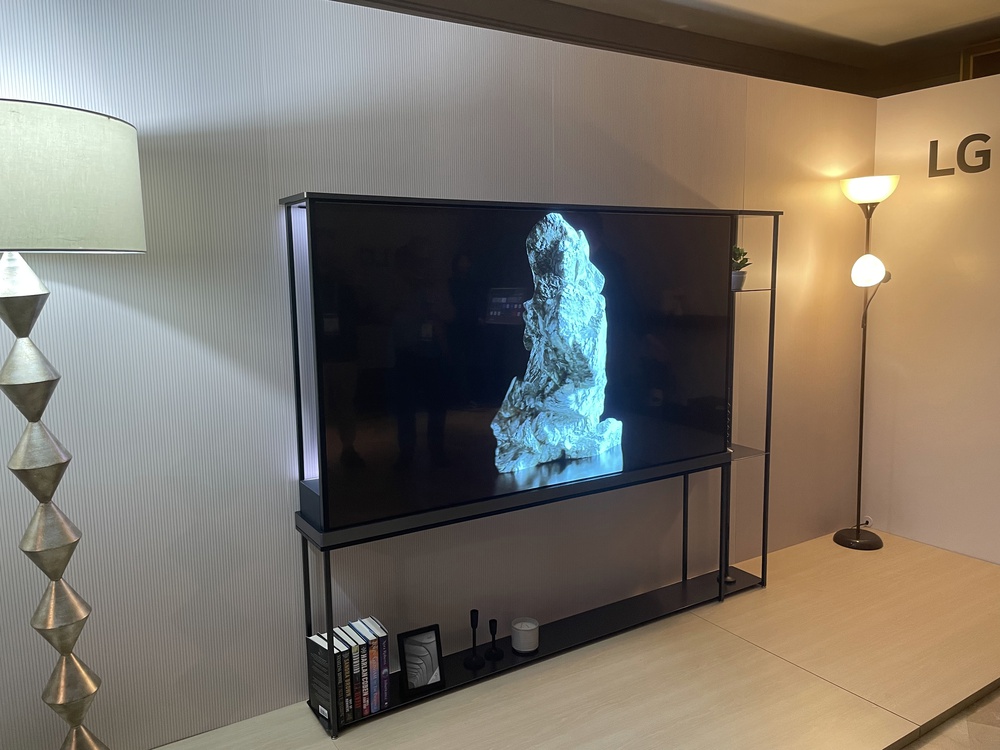
At last year's CES, LG unveiled their new transparent OLED, the LG Signature T. During CES 2025, LG officially announced the new display, and it comes with an incredibly hefty price tag of $60,000. This new display isn't targeted at consumers for use at home but is more geared towards commercial applications. However, it does have a retractable motorized shade that can be used to transform it from a transparent display to an opaque one for more regular use.
The display has two main portions: the transparent screen that makes up about 85% of the screen and a thick bottom portion that houses the electronics. The front of the electronics box is also a screen, and in one demo LG showed us last year, the bottom portion of the screen was used to display a news ticker with weather information while the top of the screen was off.
Product Naming
LG has a large lineup that covers everything from cheap and small lower-resolution TVs to very high-end with their OLEDs. The naming scheme changes depending on the lineup. Generally speaking, the first set of letters represents the lineup it's in, like QNED or NANO, and the next set of numbers represents its position in the lineup, with higher being better.
- QNED* = Premium QLED model
- NANO* = Premium LED model
- U* = Entry-level 4k TV
- *R = 2023
- *Q = 2022
- *P = 2021
For their OLED lineup, the model numbers start with a letter, followed by a number representing the year (2 = 2022, 3 = 2023, 4 = 2024). Example: G1 = 2021 Gallery Design; CX = 2020 C Series OLED TV.
LG Smart Features
Besides aesthetic changes, LG's webOS hasn't changed much over the years, which is good. A few years ago, it was, by and large, the best smart platform. While competition has tightened up since then, incremental and polishing updates allowed it to remain at the top. LG updated the platform in 2021 to include a full home page instead of the banner found in past models. LG also guarantees webOS updates for five years with their Re:New program, starting with models released in 2022. If you currently have a B/C/G2 TV, you'll receive webOS updates until 2027.
Interface
LG overhauled the interface in 2021 with the release of webOS 6.0, and it's still one of the best-looking platforms. The redesign replaces the menu ribbon of previous versions with a full-screen smart hub, complete with various widgets. Despite the new look, it has the same smooth functionality and features, making it one of the best smart platforms. It's colorful, and its animations are both intuitive and beautiful. Everything feels responsive and snappy, and you're rarely left waiting for something to happen.
Ad-free
WebOS has one glaring issue: the inclusion of advertising sprinkled around the operating system, including in the app store and web browser. The worst is that there isn't a good way to disable them from within the TV itself. However, most smart platforms are like this, as you'll get ads no matter what brand you go with.
Apps & Features
The LG content store delivers just about every app one would look for on a smart TV. Essentials like Netflix, Amazon Video, and YouTube are all installed by default, but the range continuously expands. Overall, LG TVs have one of the widest selections of apps available on any smart platform.
Voice Controls
WebOS TVs that come with LG's Magic Remote have voice control. The manufacturer redesigned the remote in 2021, but it has the same functionality as in past years. There's a big microphone button in the center of the remote, and the voice control helps search for content. Unfortunately, the voice assistant doesn't have very in-depth control of the settings, so you can't adjust the brightness without leaving what you're watching. You can't turn the TV off or change the volume, but you can still switch inputs, open apps, search for specific content, or ask what the weather is like.
In 2018, WebOS 4.0 added a new voice control processor with ThinQ AI. The system can perform advanced searches similar to Siri on Apple TV. It can identify actors, search for sports scores, and find pictures in your favorite cloud service based on keywords. It can also communicate with a multitude of smart home-connected devices, including lights and thermostats. Newer LG TVs can also interact with Google Home or Amazon Alexa-connected personal assistants.
Remote
LG's Magic Remote offers motion-controlled point-and-click functionality, making navigating menus much simpler. It isn't the smallest remote, but it's nicely sculpted and very comfortable to hold.
There are many more buttons on this remote than on other remotes, but they're clearly labeled and make it quicker to pick up and use. Some lower-end versions come with this Magic Remote, but the entry-level models have a basic remote without voice control, like the remote on the LG UT7570.
Remote App
LG's remote app, called LG TV Plus, offers quick access to most controls and is compatible with all LG smart TVs. It isn't as advanced as some other remote apps, but it does stream content from your phone or tablet to the TV. It can launch apps and change inputs directly without using a navigation button to navigate the on-screen menus.
Known Issues
There aren't many issues with LG webOS. The previous version had some performance issues, with occasional hiccups and frequent dropped frames in animations. They've fixed most of these issues, and the latest version performs extremely well, but the interface can still hang sometimes.
Recent Updates
-
We replaced the 2024 LG Lineup with a new 2025 LG Lineup section.
-
Replaced the LG QNED80 2023 with the LG QNED85T in the 'Best Lower Mid-Range LG TV' category. We also refreshed text throughout the article for accuracy.
-
Oct 08, 2024 : We swapped the LG UR9000 with the LG UT7570 in the 'Best Budget LG TV' category. We also replaced the LG B3 OLED, the LG C3 OLED, and the LG G3 OLED with their 2024 successors.
-
Jul 10, 2024 : Ensured that our picks are still available and updated some text for accuracy.
-
May 16, 2024 : Refreshed text throughout the article for accuracy and clarity.
Conclusion
LG undeniably offers top-shelf products with OLED TVs, and our LG TV reviews of their OLEDs are usually very positive since they test so well. This technology is now quite mature and is an industry leader, but not all their TVs are great. Most of their LED models really don't provide great image quality for their price, quite the opposite of their OLED offerings. Luckily, all their smart TVs come with a user-friendly webOS platform built-in, making it easy to watch your favorite content.
Test Results
Comments
Best LG TVs: Main Discussion
What do you think of our picks? Let us know below.
Looking for a personalized buying recommendation from the RTINGS.com experts? Insiders have direct access to buying advice on our insider forum.
Update: We replaced the 2024 LG Lineup with a new 2025 LG Lineup section.
What do you think of these changes? Let us know






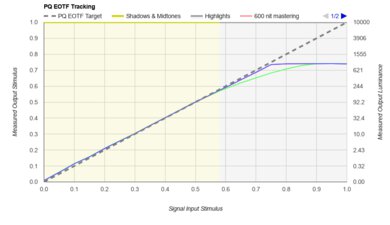









![LG UT7570 [UT75, UT7590] Design Picture](https://i.rtings.com/assets/products/swIH6vQi/lg-ut7570-ut75-ut7590/design-small.jpg?format=auto)
![LG UT7570 [UT75, UT7590] In-Test Picture](https://i.rtings.com/assets/products/sUsI35rr/lg-ut7570-ut75-ut7590/in-test-small.jpg?format=auto)
![LG UT7570 [UT75, UT7590] PQ EOTF Graph](https://i.rtings.com/assets/products/X22tTIcp/lg-ut7570-ut75-ut7590/pqeotf-graph-small.jpg?format=auto)
![LG UT7570 [UT75, UT7590] Pre Color Picture](https://i.rtings.com/assets/products/b0oOQM8g/lg-ut7570-ut75-ut7590/pre-colorspace-small.jpg?format=auto)
